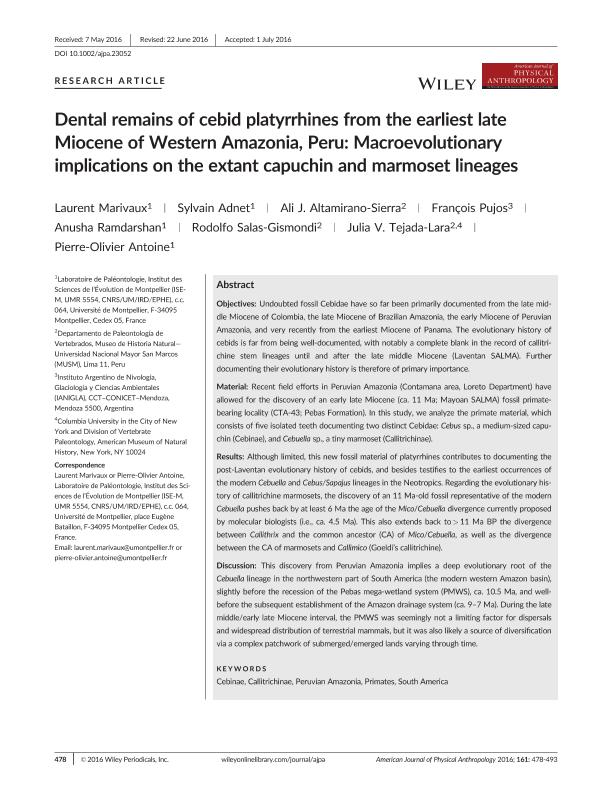Artículo
Dental remains of cebid platyrrhines from the earliest late Miocene of Western Amazonia, Peru: Macroevolutionary implications on the extant capuchin and marmoset lineages
Marivaux, Laurent; Adnet, Sylvain; Altamirano Sierra, Ali J.; Pujos, François Roger Francis ; Ramdarshan, Anusha; Salas Gismondi, Rodolfo; Tejada Lara, Julia V.; Antoine, Pierre Olivier
; Ramdarshan, Anusha; Salas Gismondi, Rodolfo; Tejada Lara, Julia V.; Antoine, Pierre Olivier
 ; Ramdarshan, Anusha; Salas Gismondi, Rodolfo; Tejada Lara, Julia V.; Antoine, Pierre Olivier
; Ramdarshan, Anusha; Salas Gismondi, Rodolfo; Tejada Lara, Julia V.; Antoine, Pierre Olivier
Fecha de publicación:
07/2016
Editorial:
Wiley-liss, div John Wiley & Sons Inc.
Revista:
American Journal Of Physical Anthropology
ISSN:
0002-9483
Idioma:
Inglés
Tipo de recurso:
Artículo publicado
Clasificación temática:
Resumen
Objectives: Undoubted fossil Cebidae have so far been primarily documented from the late middle Miocene of Colombia, the late Miocene of Brazilian Amazonia, the early Miocene of Peruvian Amazonia, and very recently from the earliest Miocene of Panama. The evolutionary history of cebids is far from being well-documented, with notably a complete blank in the record of callitrichine stem lineages until and after the late middle Miocene (Laventan SALMA). Further documenting their evolutionary history is therefore of primary importance. Material: Recent field efforts in Peruvian Amazonia (Contamana area, Loreto Department) have allowed for the discovery of an early late Miocene (ca. 11 Ma; Mayoan SALMA) fossil primate-bearing locality (CTA-43; Pebas Formation). In this study, we analyze the primate material, which consists of five isolated teeth documenting two distinct Cebidae: Cebus sp., a medium-sized capuchin (Cebinae), and Cebuella sp., a tiny marmoset (Callitrichinae). Results: Although limited, this new fossil material of platyrrhines contributes to documenting the post-Laventan evolutionary history of cebids, and besides testifies to the earliest occurrences of the modern Cebuella and Cebus/Sapajus lineages in the Neotropics. Regarding the evolutionary history of callitrichine marmosets, the discovery of an 11 Ma-old fossil representative of the modern Cebuella pushes back by at least 6 Ma the age of the Mico/Cebuella divergence currently proposed by molecular biologists (i.e., ca. 4.5 Ma). This also extends back to > 11 Ma BP the divergence between Callithrix and the common ancestor (CA) of Mico/Cebuella, as well as the divergence between the CA of marmosets and Callimico (Goeldi's callitrichine). Discussion: This discovery from Peruvian Amazonia implies a deep evolutionary root of the Cebuella lineage in the northwestern part of South America (the modern western Amazon basin), slightly before the recession of the Pebas mega-wetland system (PMWS), ca. 10.5 Ma, and well-before the subsequent establishment of the Amazon drainage system (ca. 9–7 Ma). During the late middle/early late Miocene interval, the PMWS was seemingly not a limiting factor for dispersals and widespread distribution of terrestrial mammals, but it was also likely a source of diversification via a complex patchwork of submerged/emerged lands varying through time.
Palabras clave:
CALLITRICHINAE
,
CEBINAE
,
PERUVIAN AMAZONIA
,
PRIMATES
,
SOUTH AMERICA
Archivos asociados
Licencia
Identificadores
Colecciones
Articulos(IANIGLA)
Articulos de INST. ARG. DE NIVOLOGIA, GLACIOLOGIA Y CS. AMBIENT
Articulos de INST. ARG. DE NIVOLOGIA, GLACIOLOGIA Y CS. AMBIENT
Citación
Marivaux, Laurent; Adnet, Sylvain; Altamirano Sierra, Ali J.; Pujos, François Roger Francis; Ramdarshan, Anusha; et al.; Dental remains of cebid platyrrhines from the earliest late Miocene of Western Amazonia, Peru: Macroevolutionary implications on the extant capuchin and marmoset lineages; Wiley-liss, div John Wiley & Sons Inc.; American Journal Of Physical Anthropology; 161; 3; 7-2016; 478-493
Compartir
Altmétricas



